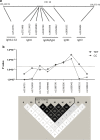Immunoglobulin M gene association with autoantibody reactivity and type 1 diabetes
- PMID: 28534223
- PMCID: PMC5486809
- DOI: 10.1007/s00251-017-0999-1
Immunoglobulin M gene association with autoantibody reactivity and type 1 diabetes
Abstract
Several lines of evidence show that autoimmune responses evolving in type 1 diabetes (T1D) patients include the generation of multi-reactive autoantibody (AutoAb) repertoires, but their role in T1D pathogenesis remains elusive. We tested the hypothesis that variants at the immunoglobulin heavy chain (IGH) locus are genetic determinants of AutoAbs against pancreatic antigens and contribute to T1D susceptibility. With this aim, two independent study designs were used: a case-control study and a family-based cohort comprising a total of 240 T1D patients, 172 first-degree relatives (mother and/or father), and 130 unrelated healthy controls living in Portugal. We found that three SNPs in the IGH locus show suggestive association with T1D with the highest nominal association at rs1950942 (in the IGHM-IGHJ gene region) in both the case-control study (P = 9.35E-03) and the family-based cohort (P = 3.08E-03). These SNPs were also associated with IgG AutoAbs against pancreatic antigens and with AutoAb multi-reactivity in T1D patients. Notably, we found that the SNP with the highest association with T1D susceptibility and IgG autoantibody reactivity (rs1950942) was also associated with anti-GAD IgM reactivity in T1D patients (P = 5.98E-03) and in non-affected parents (P = 4.17E-03). This finding implies that IGH association with autoreactive IgM is detectable irrespective of disease status.These results suggest that genetic variants at the IgM gene region of the IGH locus contribute to antibody autoreactivity and are associated with T1D. We propose that the control of autoantibody generation by IGH polymorphisms is a component of the complex architecture of T1D genetic susceptibility.
Keywords: Anti-GAD; Autoantibodies; Genetic association; IgH locus; IgM; Type 1 diabetes.
Conflict of interest statement
Ethics approval and consent to participate
All procedures performed in studies involving human participants were in accordance with the ethical standards of the institutional and/or national research committee and with the 1964 Helsinki declaration and its later amendments or comparable ethical standards. This investigation was conducted under the ethical permission obtained for the study entitled “Estudo da base genética da imunopatologia associada à Diabetes Tipo 1 na população portuguesa” granted by the Ethics Committee of the Associação Protectora dos Diabéticos de Portugal (APDP) in Lisbon. Written, informed consent was obtained from the adult participants or parents of each child participant.
Conflict of interest
The authors declare that they have no conflict of interest.
Figures




Similar articles
-
Association of IGHM polymorphisms with susceptibility to type 1 diabetes.Immunol Res. 2022 Jun;70(3):325-330. doi: 10.1007/s12026-021-09252-x. Epub 2022 Jan 20. Immunol Res. 2022. PMID: 35048256
-
Shared Genetic Basis for Type 1 Diabetes, Islet Autoantibodies, and Autoantibodies Associated With Other Immune-Mediated Diseases in Families With Type 1 Diabetes.Diabetes Care. 2015 Oct;38 Suppl 2(Suppl 2):S8-13. doi: 10.2337/dcs15-2003. Diabetes Care. 2015. PMID: 26405073 Free PMC article.
-
PD-L1 gene polymorphisms and low serum level of PD-L1 protein are associated to type 1 diabetes in Chile.Diabetes Metab Res Rev. 2014 Nov;30(8):761-6. doi: 10.1002/dmrr.2552. Diabetes Metab Res Rev. 2014. PMID: 24816853
-
[Immune markers of type-I diabetes mellitus in children with diabetes in their first-degree relatives. Part I].Przegl Lek. 2003;60(9):580-4. Przegl Lek. 2003. PMID: 15065337 Review. Polish.
-
The genetic architecture of type 1 diabetes mellitus.Mol Cell Endocrinol. 2018 Dec 5;477:70-80. doi: 10.1016/j.mce.2018.06.002. Epub 2018 Jun 18. Mol Cell Endocrinol. 2018. PMID: 29913182 Review.
Cited by
-
Serum APOC1 levels are decreased in young autoantibody positive children who rapidly progress to type 1 diabetes.Sci Rep. 2023 Sep 24;13(1):15941. doi: 10.1038/s41598-023-43039-4. Sci Rep. 2023. PMID: 37743383 Free PMC article.
-
Exploring Computational Data Amplification and Imputation for the Discovery of Type 1 Diabetes (T1D) Biomarkers from Limited Human Datasets.Biomolecules. 2022 Oct 9;12(10):1444. doi: 10.3390/biom12101444. Biomolecules. 2022. PMID: 36291653 Free PMC article.
-
Screening differentially expressed genes between endometriosis and ovarian cancer to find new biomarkers for endometriosis.Ann Med. 2021 Dec;53(1):1377-1389. doi: 10.1080/07853890.2021.1966087. Ann Med. 2021. PMID: 34409913 Free PMC article.
References
Publication types
MeSH terms
Substances
LinkOut - more resources
Full Text Sources
Other Literature Sources
Medical
Miscellaneous

